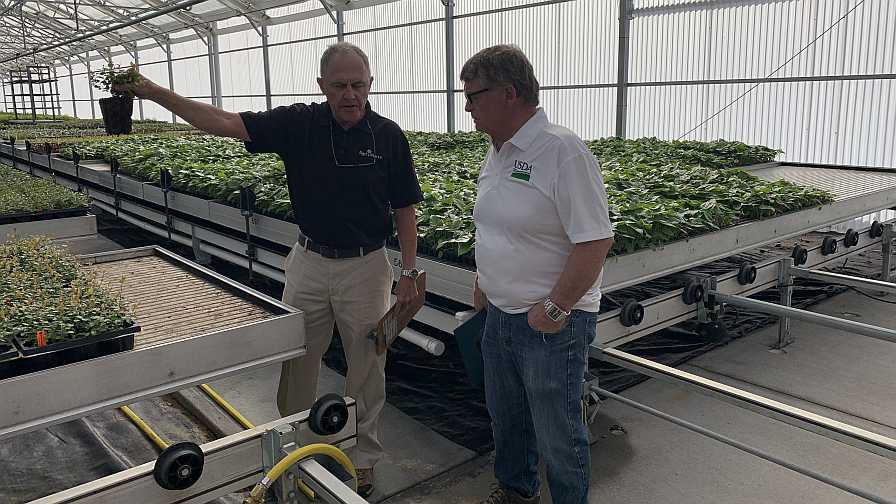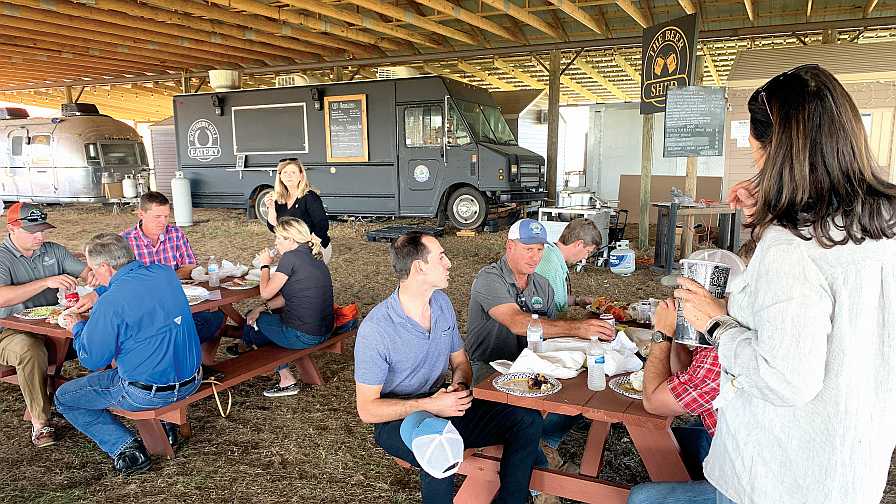What Can Be Done to Improve Crop Insurance?

Randy Strode (left), President of Agri-Starts in Apopka, gave a tour of his facility, which grows many different ornamental and fruit crops using tissue culture. Martin Barbre (right), USDA’s Risk Management Agency Administrator, was on hand recently to hear about improvements that can be made to a new nursery federal crop insurance plan currently in development.
Photo by Frank Giles
Language in the 2018 Farm Bill provides continued support for the federal crop insurance program and also provides guidance to USDA’s Risk Management Agency (RMA) to engage with specialty crop producers to design policies more suited for their unique seasons and challenges.
You can see the crop insurance program’s popularity in the numbers. Last year, 1.1 million crop insurance policies provided $110 billion in protection on more than 559 types of crops covering 340 million acres. While many crops are covered, some argue that major crop insurance elements are built around (too much so) the Midwest row crop commodities like corn and soybeans.
Martin Barbre, RMA’s Administrator, was in Florida recently touring farms to learn how crop insurance programs could be modified to better fit the needs of specialty crop growers. Joining him on the tour were Davina Lee, Director of the Valdosta RMA Regional Office (which covers Florida), and Matthew Wilkin, Deputy Director of the Valdosta office. The tour was hosted by Farm Credit of Central Florida and stops featured local strawberry, blueberry, ornamental nursery, and citrus operations.
Hearing from Growers
Barbre is a grain grower from Illinois, and he says he comes to the RMA Administrator’s role with an appreciation for the unique challenges that farmers face, especially when circumstances require the help of crop insurance.
“Being a farmer, I understand the frustrations of ag producers and want to be sure we build these insurance policies to be the best they can be and remain sound,” Barbre says. “I believe it is important for me to get out and hear directly from farmers. Just about everywhere we go, we hear from producers that there are certain things they like about our policies that are working well and other things that can be improved.”
It is a good time to get grower feedback, because new policies are being developed for key specialty crops. A new nursery policy is being developed for select counties in Florida. RMA also is working on a new strawberry policy, as well as policies to replace the current fresh-market tomato, fresh-market sweet corn, and pepper policies offered in Florida.
“Due to the implementation of the 2018 Farm Bill and available resources, these policies are tentatively scheduled to be offered beginning with crop year 2021. However, this is subject to change,” Lee says.
Regina Thomas, Senior Vice President of Farm Credit of Central Florida, arranged the tour stops. She says it was great to have Barbre and his team interact with local Florida growers.
“One of the best things is knowing that Martin is a farmer,” she says. “He can relate to our growers, and that really opened the door to great dialogue on the tour.”

The group made a stop at Southern Hill Farms for lunch and to tour the blueberry operation. While they were there, they learned about its agritainment and U-Pick business. Blueberry growers are asking for a crop insurance policy that begins and ends more in tune with their season.
Photo by Frank Giles
Better Timing
Thomas said one of the larger take-home messages from the various farm visits is that the growing seasons for specialty crops don’t really sync well with the timing of current crop insurance policies. One of the reasons for this is because the policies have been written around the major row crops in the Midwest.
“If you take blueberries, their growing season really starts in August and September when they start working to get the crop ready for the harvest in spring,” she says. “We are writing that policy in November, so the coverage starts and ends in the mid-season. If we get a late-season hurricane, leaves the growers waiting for months on insurance policy payments.”
Thomas also says the Whole-Farm Revenue Protection policy needs modifying to be more available and fit specialty crops better.
Citrus Retake
The tour made stops at Beck Brothers grove in Windermere and Heller Bros. citrus packinghouse in Winter Garden. Barbre heard about challenges impacting their businesses, including Hurricane Irma recovery, post-bloom fruit drop, and HLB.
Currently, the citrus industry is developing a new policy using a 508(h) application process, which allows growers to propose a crop insurance plan they design. The citrus industry is developing the program with the help of Florida Citrus Mutual (FCM) and AgriLogic Consulting, a private insurance firm.
Andrew Meadows, Director of Communications for FCM, was on the tour to provide updates on the new citrus policy proposal. He noted that Mutual, along with its partner AgriLogic, are working to develop an actual production history (APH) program to supplement the currently available catastrophic crop insurance program.
The week following the tour, FCM hosted its fourth meeting for insurance agents to hear about the program and provide input. More than 50 people attended the meeting.
“Agents asked many questions during the meeting regarding co-mingled groves, implementing an APH program in the era of HLB, and how they tie to the WHIP (hurricane relief) program,” Meadows says. “The plan is to implement a dual transitional program where growers can choose between the dollar (catastrophic) program and an APH program. RMA has said they would consider offering both programs for a period of time if the need is there for growers. Originally, FCM and AgriLogic planned on submitting the draft APH program to RMA in early April, but that date has been pushed back until July so the FCM Board can discuss the course of action at its April meeting.”
Make Your Voice Heard
Barbre and his team say they appreciated the opportunity to visit with Florida growers and their hospitality.
“We look forward to continued collaboration with growers and stakeholders as we move forward, improving our policies, and ensuring they are working as intended while remaining actuarially sound,” Lee adds.
Growers with questions, concerns, or suggestions on federal crop insurance can reach out to the regional RMA office at [email protected] or call 229-242-7235. The website, RMA.USDA.gov, offers additional information.










